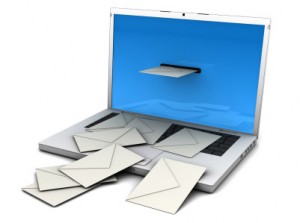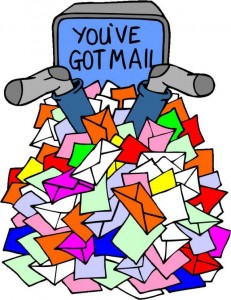
Email marketing doesn’t just have to be for the big boys! More and more small businesses are increasingly seeing the benefits of email marketing, even when just working on a small and local level. In fact, when done well it can work very effectively for those of us wanting to relate to our customers on a personal and friendly level. It helps keeps our business on people’s radar, can keep others in the know of what’s going on in our business – offers, new products, or upcoming events or workshops that may be of interest to them.
But before leaping in headfirst into a full-blown email marketing campaign, why not try these on for size? Here are 4 BIG DO’s and 4 BIG DON’Ts when thinking through and implementing your email marketing campaign for your business.
1. DON’T just hop on the email marketing bandwagon.
It’s very rarely a good idea to start doing something in your business “just because everyone else is doing it”. We’re not in high school anymore (thank goodness!). Have a think whether email marketing would be appropriate and worthwhile for your business. If you are B2B, then it is likely that email marketing on some level would be a good idea. If you are e-commerce, then email marketing is a must, as your customer base is clearly online. Even if you are selling stairlifts and are predominantly aiming at an older target audience, don’t automatically rule out email marketing – I know a good number of 60-70 year olds who know and love the web! In today’s world I imagine that it is likely some form of email marketing campaign would be of useful to most businesses, but please do think it through and make sure you are clear of your strategy and what you are hoping to achieve out of doing it.
2. DO get legal.
 Nobody likes receiving emails they never requested to receive. It’s called spamming. Make sure that you are up-to-date with the current anti-spam laws regarding email marketing in the UK, and in other countries if you are sending emails internationally). Click here to view the UK regulations. But in a nutshell, recipients in our country have to have actively opted-in and requested to be added to a mailing list, whether by receiving a personal invitation from you, or by them filling in an online form on your website, or by them filling in a paper form at your tradeshow stand or something similar. In any case, it’s a good idea to keep a record of these sign-ups for legal purposes in case you ever get accused of spamming people. By law, every email you send also has to include an ‘opt-out’ option, such as an ‘unsubscribe’ link or clear instructions for the recipient to follow should they decide they no longer wish to receive these emails from your business.
Nobody likes receiving emails they never requested to receive. It’s called spamming. Make sure that you are up-to-date with the current anti-spam laws regarding email marketing in the UK, and in other countries if you are sending emails internationally). Click here to view the UK regulations. But in a nutshell, recipients in our country have to have actively opted-in and requested to be added to a mailing list, whether by receiving a personal invitation from you, or by them filling in an online form on your website, or by them filling in a paper form at your tradeshow stand or something similar. In any case, it’s a good idea to keep a record of these sign-ups for legal purposes in case you ever get accused of spamming people. By law, every email you send also has to include an ‘opt-out’ option, such as an ‘unsubscribe’ link or clear instructions for the recipient to follow should they decide they no longer wish to receive these emails from your business.
3. DON’T stuff it with too much!
Be picky about what content you choose to include in your email. Many of the best email marketing campaigns work best because they provide short and well-written tasters of useful information that is relevant to the recipient (with links to more info on certain topics if required). The exact content of your email will of course depend on your strategy, but one tip is to remember that it is not all about selling. The email is meant to be informative and an instrument for helping people engage with your business. Keep it friendly, and full of value-added content so that the reader feels they get something out of being on your regular mailing list. By keeping it short but sweet, this will keep your readership numbers up and your ‘unsubscribe’ numbers down.
4. DO include links in your email to other online points of engagement with your business.
Make it easy for your readers to follow your activities or contact you via their preferred platform. Do you have a Facebook page or use Twitter? Include some links to these. What about a blog which can be subscribed to via RSS? Promote this in your email, as well.
5. DON’T assume that one email fits all.
Why not split your mailing list into smaller subgroups, and send out a few different emails that are each specially tailored to be of interest to each group of people. Do you offer a range of different products or services? Do you have a wide mix of different customers? It makes sense to personalise your email to them so they are more likely to read it and engage with your business.
6. DO use a decent HTML template for your email.
Almost all email clients now do a good job of correctly displaying HTML emails (when it’s coded well, that is) which means that we as businesses now have the luxury of making professional and pretty-looking emails to send out to our mailing lists. There are a number of really useful online interfaces out there to assist in sending out a HTML email campaign. Mailchimp, for example, has a number of ready-made templates which you can modify to your liking relatively easily, and lets you send out 12,000 emails per month to a mailing list of up to 2,000 email addresses for free. I have built a number of professional looking e-newsletter templates for clients in HTML, designed to their liking, which I have then imported into Mailchimp for the client to easily edit as they wish for each monthly or weekly mailing. So do let me know if you could do with a hand with this.
7. DO include a plain-text version of your email and a ‘view in browser’ link. Granted, most email clients can now decently render HTML emails. But these types of tools are still useful – they give the recipient some decent alternatives if they would prefer only to view a plain-text version (without viewing the images in the email) or are unable to view HTML in their email client, for example, if they are using a mobile device that doesn’t support HTML.
8. DON’T just send it out and hope for the best.
If you are investing valuable time and money into your email marketing, you’ll want to know how effectively it’s working. Of course how you monitor this all depends on your objectives of the campaign. But one obvious way of monitoring performance is to be able to see how your recipients are responding to your email. Who opened it? What links in the email did they click on? Who has unsubscribed? At what time of day of sending does your email get the best response? “But how can I get hold of all this information?”, I hear you ask. The good news is that good ol’ Mailchimp gives you free access to this data when you use their platform to send out your campaigns. Click here for more info about Mailchimp reports.
Thanks for reading. Any comments are welcome. And of course do feel free to get in touch if I can help with your email marketing in any way.
![]()
